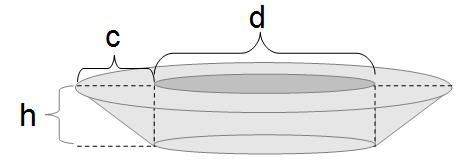Chamfer Volume
Tags | |
UUID | 9e08a939-1f38-11e4-b7aa-bc764e2038f2 |
The Chamfer Volume calculator computes the volume of a chamfer based on the inner diameter, top width, chamfer height. 
INSTRUCTIONS: Choose units and enter the following:
- (d) Inner Diameter
- (c) Top Width
- (h) Chamfer Depth
Volume of a Chamfer (V): The calculator returns the volume in cubic millimeters (mm3). However, this can be automatically converted to compatible units via the pull-down menu.
Piston Chamfer
A piston chamfer is the bevel cut into the top of the block around the piston bore. It allows the rings to be more easily inserted in the cylinder.
Some engine manuals calculate the chamfer volume differently. They take the difference of the diameters (bore and piston), multiply that difference by the circumference of the bore to create the surface area of the chamfer and then multiply that surface area by the depth of the chamfer to get twice the volume. The author disagrees with those manuals, because they are geometrically wrong (just like the piston crevice formula). Without the piston bore, the bevel is an upside-down frustum of a cone. To get the chamfer volume, you calculate the volume of that cone frustum, and then remove (subtract) the volume of the cylinder that would be in that frustum. This equation does that.
| Inch Equivalences | |||
| Fraction | Decimal | Mils | |
| 1/16th | 0.0625 | 62.5 | |
| 1/32th | 0.03125 | 31.25 | |
| 1/64th | 0.015625 | 15.625 | |
Combustion Engine Calculators
Ratios and Lengths
- Cylinder Bore Diameter: Computes the diameter (bore) based on the engine displacement, number of cylinders and the stroke length.
- Bore Stroke Ratio
: Computes ratio based on the diameter of the bore and the length of the stroke.
- Combustion Ratio: Computes ratio base on the minimum and maximum displacements of the cylinder at the beginning (1-Induction) and compressed (3-Power) portions of the combustion cycle
- Displacement Ratio: Computes ratio based on the volumes at the beginning and end of the stroke.
- Rod and Stroke Length Ratio: Computes ratio base on the rod and stroke lengths.
- Stroke Length: Computes the required stroke length based on the total engine displacement, number of cylinders and the bore.
- Piston Position: Computes the piston position based on the crank angle, crank radius, and rod length.
- Piston Deck Height: Computes deck height based on Block Height, Rod Length, Stroke Length, and Pin Height.
Volumes and Displacements
- Total Volume (displacement) of a Combustion Engine: Computes volume based on the bore, stroke and number of cylinders.
- Volume (displacement) of a Engine Cylinder: Computes volume based on the bore and stroke.
- Volume (displacement) of an Engine with an Overbore: Computes volume based on the stroke, bore, overbore and number of cylinders.
- Equivalent Volume of a Rotary Engine: Estimates rotary engine volume based on the swept volume and number of pistons.
- Carburetor Air Flow: Estimates the volumetric flow of air through a carburetor based on a four-stroke engine's displacement, RPMs, and volumetric efficiency.
- Compressed Volume of a Cylinder:
Compute volume when the piston is at the end of the stroke and the chamber is at its smallest (and most compressed) volume, based on the chamber, deck, crevice, chamfer, gasket, valve relief and dome/dish volumes. This is the second volume (V2) in the Compression Ratio calculation.
- Volume of a Gasket: Computes gasket volume (displacement) based on the inner and outer diameters and the gasket's thickness.
- Volume of a Cylinder Deck: Computes the deck volume based on the deck height and the bore.
- Volume of a Cylinder Crevice: Computes crevice volume based on the piston diameter, cylinder bore and the crevice height.
- Volume of a Cylinder Chamfer: Computes chamfer volume based on the cylinder diameter and the chamfer height and width.
- Clearance Volume of a Piston: Computes the volume remaining in the combustion chamber when the piston is at its top dead center (TDC) which is the space above the piston crown when it's at its highest point in the cylinder.
- Engine Compression Ratio: Computes the ratio of the volume of the combustion chamber with the piston at its bottom dead center (BDC) to the volume with the piston at its top dead center (TDC).
Speeds and RPMs
- Piston Speed (mean): Computes the mean (average) piston speed based on stroke length and RPMs.
- Max Piston Speed: Computes max speed based on stroke length and RPMs
- RPMs: Computes revolutions per minute based on piston speed and stroke length.
Automotive Calculators
- Combustion Engine Calculator: Functions and data related to engine mechanics.
- Camber Angle: Camber angle of a tire based on size and offset.
- Camber Offset: Camber offset of a tire based on size and angle.
- Breakover angle: Ground clearance between axles
- Approach angle: Ground clearance in front of or behind vehicle.
- Belt Length: Length of a belt between and around two pulleys.
- Belt Speed: Speed of belt based on pulley RPMs and diameter.
- Pulley RPMs: Pulley RPM based on belt speed and pulley diameter.
- 2nd Pulley RPMs: RPMs of second pulley connected to a pulley, based on RPM and diameter of primary pulley and diameter of 2nd pulley.
- 2nd Pulley Diameter: Diameter needed of a second pulley connected to a primary pulley based on primary pulley diameter and RPMs, and desired RPMs of second pulley.
- RPM of 4th pulley on three shafts : RPM of a 4th pulley in a series based on diameters and initial RPM.
- 2nd Gear RPM : RPM of a second gear based on teeth in the primary and secondary gears and the RPMs of the primary gear.
Equations and Data Items
Calculators
- Comments
- Attachments
- Stats
No comments |

